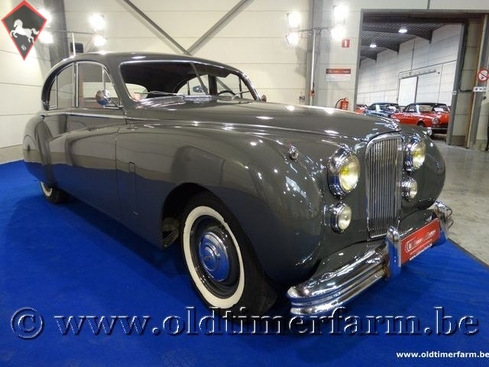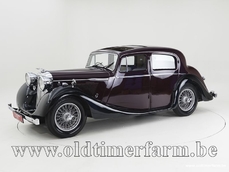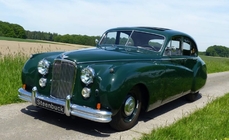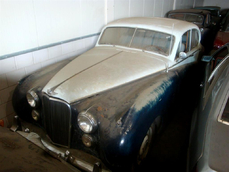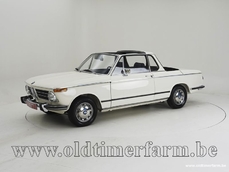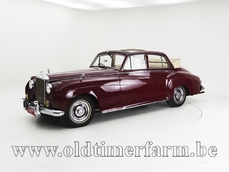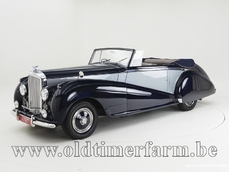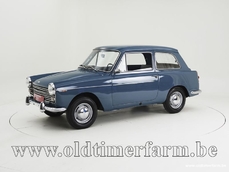Jaguar MkVII VII 3.4 '52 1952
General description :
Lowered price from €32.950 -> €28.500
The Jaguar Mark VII was a large four-door sports saloon car launched by Jaguar Cars of Coventry at the 1950 London Motor Show. It replaced the Jaguar Mark V, but as there was a Bentley Mark VI already on the market, Jaguar decided to call the next model Mark VII. A version of the Jaguar Mark V with the XK engine had been designated the Jaguar Mark VI, but it is thought that only two were built.
The Mk VII chassis came from the Jaguar Mark V with which the Mark VII shared its 10 feet (3,048.0 mm) wheelbase. But for this latest offering Jaguar designed a modern and streamlined looking body, featuring fully integrated headlights and mudguards along with an increased rear overhang which gave the car enhanced presence. As on the Mark V, the upper part of the rear wheels was covered by the body work (properly called spats, and removable for flat tyre wheel changes). In place of its predecessor's flat windscreen, the Mark VII design included a two piece front screen, adumbrating the gently curved one piece screen that would become available with the Jaguar Mark VIII.
The predecessor model had been powered by an engine of prewar design, originally developed by the Standard Motor Company. The Mark VII featured the remarkable newly developed XK engine first seen in production form in the 1948 XK120. The 3442 cc straight-six engine provided the same 160 bhp (119.3 kW) power output in this application as in the Mark VII's sports car contemporary. Despite its size, a top speed in excess of 100 mph (160 km/h) was claimed for the Mark VII.
During its development period it was clear that the car would find most of its customers overseas, thanks both to government policy and a car tax regime at home which heavily penalised buyers of cars with larger engines. The published performance figures required use of the standard 8:1 compression ratio, but this was unsuitable for the reduced octane Pool petrol which was the best publicly available to UK motorists, and it was possible to specify a reduced 7:1 compression ratio when only "poor grade fuel" was available. British motoring magazines such as The Autocar testing the car's performance for their readers overcame this problem by taking the test car to Belgium where 80 octane fuel was available and where the "autoroute" linking Ostend to Brussels was at that time straight enough and a section of it at times empty enough to permit measurement on a public highway of the car's performance.
A car tested by the British magazine The Motor in 1952 had a top speed of 101 mph (163 km/h) and could accelerate from 0–60 mph (97 km/h) in 13.7 seconds. A fuel consumption of 17.6 miles per imperial gallon (16.1 L/100 km; 14.7 mpg-US) was recorded. The test car cost £1693 including taxes.
The Jaguar Mark VII's arrival coincided with some relaxation of the desperate economic situation that pervaded Britain after the Second World War. Already in 1951 the enthusiastic reception of the Mark VII in the UK and US markets was given by the company as the reason for their relocation to larger premises, in a plant built for wartime production as a so-called "shadow factory" and now available for immediate use.[4] By the time of the Mark VII's 1954 upgrade, 20,908 had been produced.
Specifications
Bodywork
Length : cm (in): 499 (196.4)
Width : cm (in): 185 (73)
Height : cm (in): 160 (62.9)
Wheelbase : cm (in) : 305 (120.1)
Weight: kg (lb) : 1735 (3830)
Mechanics.
Displacement : straight six 3442 cc (210 ci), front mounted
Valve gear : 12
Fuel system : 2 SU carburettors
Gearbox : manual 4 speed
Drive wheels : rear wheel drive
Maximum power : 160 bhp at 5200 rpm
Maximum torque : 237 Nm at 2500 rpm
Maximum speed : 165 km/h (103 mph)
http://www.oldtimerfarm.be/en/collection-cars-for-sale/3655/jaguar-mk-vii-34-52.php
1952 Jaguar MkVII VII 3.4 '52 is listed sold on ClassicDigest in Aalter by Oldtimerfarm Dealer for €28500.
Car Facts
Car type : Car Make : Jaguar Model : MkVII Model Version : VII 3.4 '52 Engine size : 0.0 Model Year : 1952 Location : Aalter
Sold
Seller Information
Sold
People who viewed this Jaguar MkVII also viewed similar Jaguar listed at ClassicDigest
Other cars listed for sale by this dealer
About Jaguar
Ah, the story of Jaguar, from its early days as the SS Cars Ltd. to its pinnacle with the D-type, and the street-going evolution in the form of the iconic E-type. There's something quintessentially British about this tale, and I'll narrate it as a British journalist might.In the Beginnings:
Our journey into the world of Jaguar begins in the 1930s, when a company known as SS Cars Ltd. emerged. Despite the unfortunate coincidence of their initials with the rising political tensions in Europe, they started producing stylish and performance-oriented cars. The SS 100, introduced in 1936, was a symbol of elegance and speed, setting the stage for what would become Jaguar.
The Birth of Jaguar:
As the shadows of World War II loomed, SS Cars Ltd. wisely decided to disassociate themselves from the SS initials. Thus, in 1945, they officially became Jaguar Cars Ltd., a name that would soon be synonymous with British luxury and performance.
The XK Series:
Jaguar's post-war era brought us the XK 120, a true sensation in 1948. With its sleek design and a powerful 3.4-liter inline-six engine, it became the world's fastest production car. The XK 120 was the blueprint for what lay ahead – Jaguars that blended style with speed in a uniquely British fashion.
The D-type Dominance:
Then came the D-type, a true racing legend. Introduced in 1954, it won Le Mans three times in the 1950s, showcasing Jaguar's engineering prowess. With its innovative monocoque construction and the iconic fin at the back, the D-type was the apex of Jaguar's motorsport success.
The E-type Emergence:
But the true turning point arrived in 1961 with the introduction of the E-type, often described by Enzo Ferrari as "the most beautiful car ever made." Its long bonnet, curvaceous body, and a 3.8-liter engine delivering exhilarating performance made it an instant classic. The E-type was not just a car; it was a work of art on wheels, and it could hit 150 mph on the road.
Street and Racing Success:
The E-type's beauty was matched by its capability on the track. The lightweight E-types were particularly successful in various racing events, cementing Jaguar's reputation as a force to be reckoned with in motorsport.
The Age of Refinement:
As we delve deeper into the Jaguar story, we find that the 1950s and 1960s were an age of refinement and expansion. Alongside the magnificent D-type and the E-type's iconic emergence, Jaguar introduced models that further solidified its reputation for luxury and performance.
The MK2:
In the late 1950s, Jaguar unveiled the MK2, a sports sedan that combined elegance with power. This sleek four-door saloon was a favorite of bank robbers and law enforcement alike, thanks to its exceptional speed and handling. The MK2 was a symbol of Jaguar's ability to blend sophistication with performance and had a successful racing career as well.
The XJ6:
Fast forward to 1968, and Jaguar launched a car that would define luxury saloons for decades to come – the XJ6. It was a masterpiece of engineering and design, featuring a smooth inline-six engine, independent rear suspension, and a spacious, beautifully appointed interior. The XJ6 was a symbol of British elegance and provided a ride so smooth that it seemed to glide over the road. It became the flagship model for Jaguar and set the standard for luxury saloons, showcasing a level of refinement that left competitors in awe.
The Blend of Classic and Modern:
While the MK2 and XJ6 represented the evolution of Jaguar's saloon cars, they maintained the brand's commitment to performance and luxury. These cars didn't just belong on the racetrack; they were equally at home cruising down the grand boulevards or gliding through the English countryside.
The Challenges of Change:
However, as the 1970s arrived, Jaguar, like many British automakers, faced financial challenges and changes in ownership. The British Leyland era brought both opportunities and struggles, as the brand navigated through various mergers and transitions.
Nevertheless, the legacy of the MK2 and XJ6, along with the D-type and E-type, continues to define Jaguar as a manufacturer that combines timeless elegance with a spirit of performance. These classic models, whether driven on winding roads or parked as collectors' treasures, serve as a testament to Jaguar's enduring presence in the world of automotive excellence.
The Jaguar story, from its early days as SS Cars Ltd. to the creation of automotive icons like the E-type, MK2, and XJ6, is a journey that reflects the very essence of British motoring – a blend of luxury, power, and style that continues to captivate enthusiasts and connoisseurs alike.
